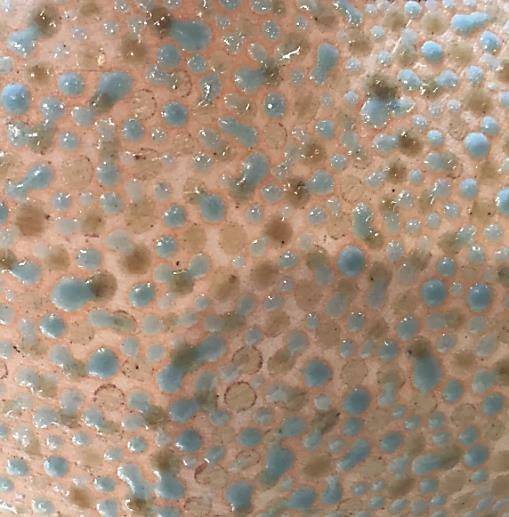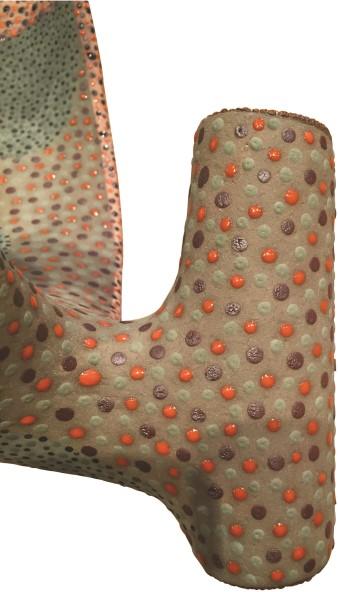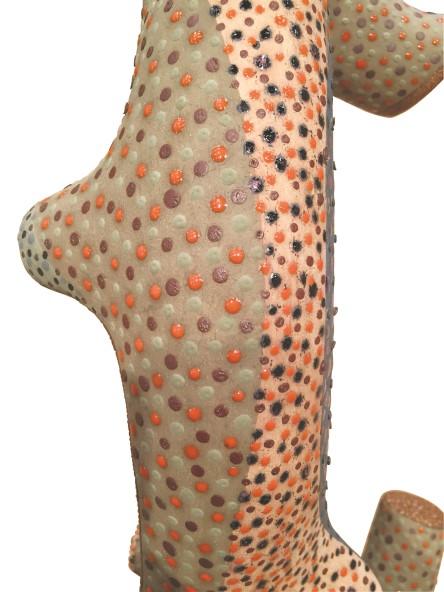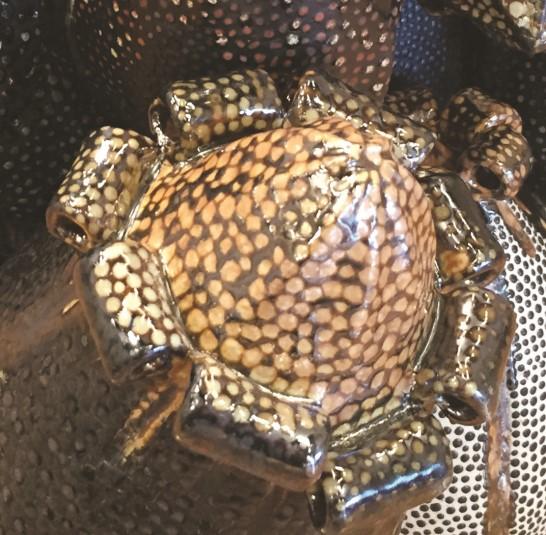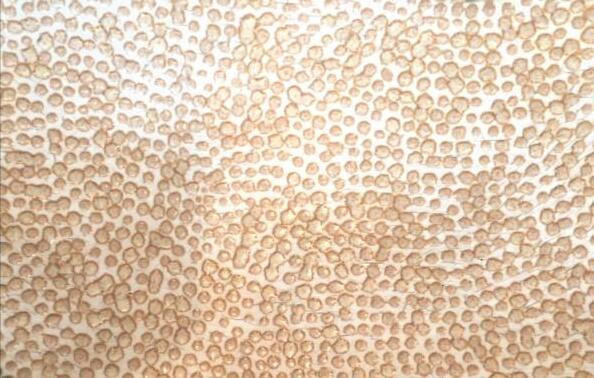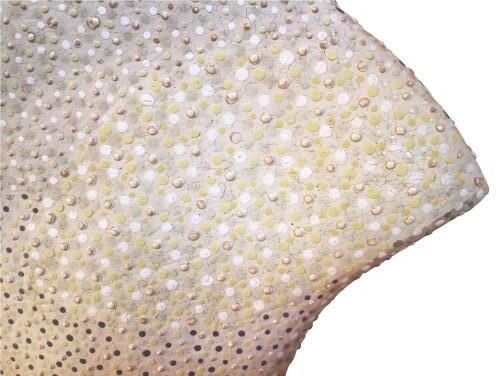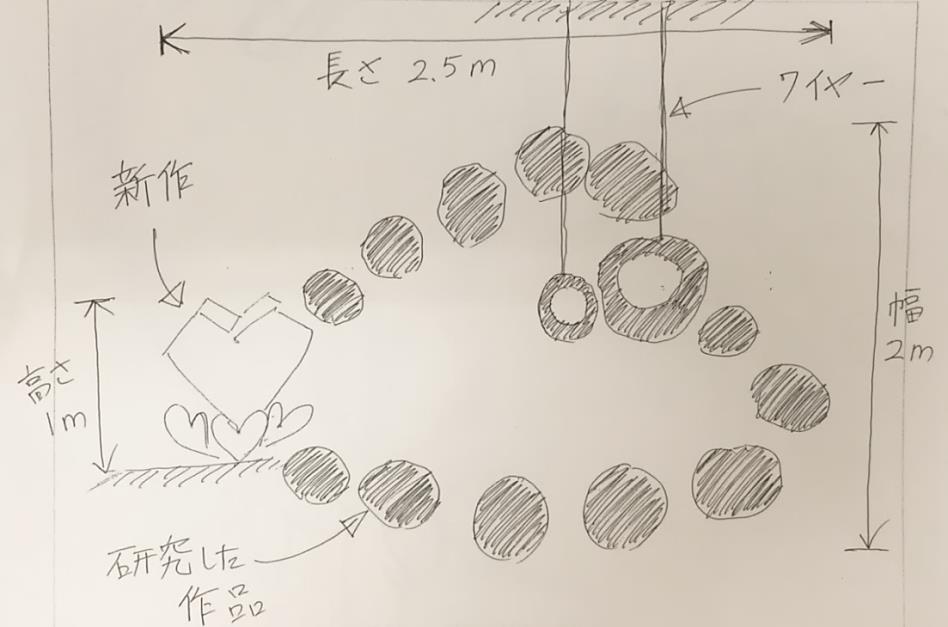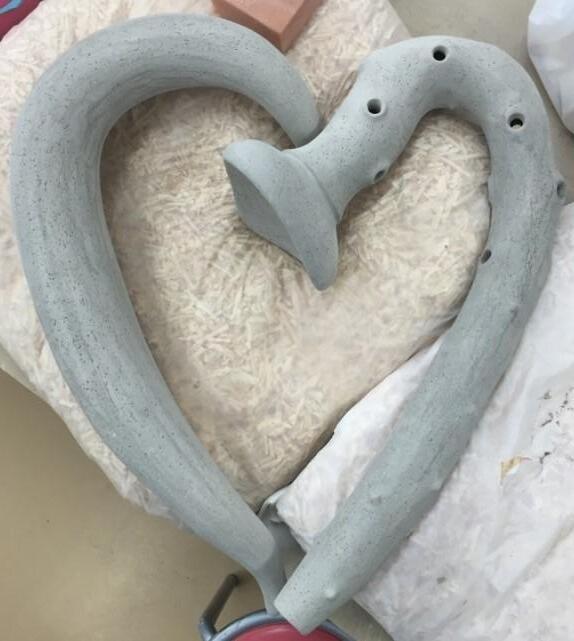I.3.2. The current problem
This stippling method was a collection of irregularly melting dots at the beginning of the development, caused by overflowing glazes. It was a visibly disorderly condition as in the Figure I-27.A and I-27.B.
Figure I 27.A Transiency
Figure I 27.B Surprised 53x26x48 cm, ceramic, 2014
26x32x40 cm, ceramic, 2014
Figure I 27.A,B detail of melting glazed dots
At the present, these glazed dots are somehow in a controllable condition as in the Figure I-28 below
Figure I 28 detail of melting glazed dots Was It As It Was Seen, detail of the installation, ceramic, own work archive, 2015
Occasionally, over-thickness of glazes causes these dots to melt into a flat surface.
Figure I 29.A Acerb
Figure I 29.B Was It As It Was Seen detail, 26x26x37cm, ceramics, 2014 detail, ceramics, own work archive, 2015
Figure I 29.A,B detail of melting glazed dots
This instability is difficult to control yet it is a nature of glazed ceramics.
To me, glaze is a potential element that distinguishes ceramics from other mediums such as glass or fibre-reinforced plastic The instability of glaze which is easily faded by firing temperatures has as well contributed to the organic physic-structural features of my interpretation
On the other hand, the more the glazed dot is beautifully controllable, the more the number of dots has to be increased on a surface; otherwise the distance between two dots accidentally shows up the body’s natural colour. To solve this problem, coloured engobe is applied as background coating to cover the targeted area in advance. The advantage of this solution is an outcome of a harmonious colour shade produced by the background coating and the colour scheme on top. And if observed from a distance, the colour of the whole surface appears more substantial
As the next development regarding the extent of a number of applicable glazes, white engobe is stippled as a base of each dot in advance and then glaze will be applied on these engobe dots. By following this procedure, even the most flowing glaze is nicely preserved into a dot shape after melting by firing. The figures below present the conditions of luster glaze, which is a very flowing glaze, on my previous and the latest sculpture.
Figure I- 30 without engobe base dots
Figure I- 31 with engobe base dot detail of Reflection, detail of The Entrance Exists, 33x32x39cm, ceramics, 2014 50x80x110cm, ceramics, 2016
I.3.3 Future development
The controllability of stippled dots’ shape has extended the possibility of revising their scale. These colourfully-glazed dots are being employed as a glazing method at the present. In the future, in order to enhance the meaning of these glazed dots, an adaption of Braille code is being considered. If this adaption can be successfully achieved, a sculpture will not be merely my interpretation through a synthesis of shape and decoration but its concept will also verbally unify with its physical structure
According to my experiences of modelling clay sculptures, I must often depend not merely on my visual ability but also my tactual sensation, for instance, to adjust the evenness of a surface or to examine the clay’s wetness. In the end, the sculpture wholly becomes a piece of visual art during an exhibition. This interesting transformation has caused me to question how
visually impaired people who must depend entirely on their haptic experiences to ‘view’ the sculpture would respond to it. On an extreme level, it is such a blessing to be able to translate my imagination into reality without any limitation from my physical body. I was extremely admired while reviewing a catalogue of artifacts created by the blind in the past. Our mutual exposure could be the same, which might be considered as an immersing ourselves into the creative process in order to recover vigor. I therefore intend to profoundly enhance my knowledge regarding this interrelationship.
On the other hand, there yet remain issues within my current modelling method. Firstly, it is the resolution of the assembly method Depending on the limited volume of the available electric ceramic kiln as well as my own physical strength, I often have to divide a desired scale of structure into smaller parts. And the assembly method has somehow caused the whole structure to be weak in physical balance. Secondly, the epoxy resin used to unite ceramic portions with each other should be considered as well. Otherwise, these two issues would lower the standard of my sculptures Albeit entire freedom in an artistic creative process is my insistent aim, it has occasionally caused a physical imbalance in a composition when I subconsciously model a large-scale sculpture. From now on, I would like to focus on this weakness in order to develop a better integration between physical and visual effect. Merely with this outcome, the sculpture could be ‘viewed’ by tactile sensation and extended to a broader spectrum of imaginative ability which is transferred from this touching enjoyment.
Chapter
II - Process of the artwork for completion in Master’s Program in Art and Design
II.1 Theme
This interpretation is my expectancy regarding the relationship between my inner world and the outside world. Consequently, I named it The Entrance Exists, which means the entrance guiding to my creative activity.
II.2 Background of this creating process
With this interpretation I question what my creating activity up to now is. The artistic creation is considered my interpretative means, or my individual ‘language’ in another sense. It is my emotional reaction upon the milieu that has translated into a physical existence through the creative working process.
In my situation, besides my native language, I have been learning English and Japanese in order to be able to make conversation with local people, and to read documentation. The rationale is the ability to communicate, as well as a desire to verbally explain my opinions It is a normal human demand according to either humankind or nationality, albeit the English, which is considered as an international common language, is not really activated in any country.
Better than a language, is there an existence of a more perceivable means of communication? I consider that it is music. Unfortunately, unlike music, a visual artwork owns weakness that could prevent it from being acclaimed for its cosmopolitan contribution, yet it can potentially play a role of cultural exchange. In addition, can we say that the greater insight people have acknowledged for their own, the more sympathetically they could express towards other’s trouble or towards an artwork which is carrying a mental sense for instance?
But, how can we enjoy a visual artwork? There are normally two modes The first one is an appreciation upon its aesthetic sense without prejudicial attitude And the second one is an art appreciation which is based on advanced critical review from art professionals. I am often questioning which mode should be an appropriate art enjoyment. Whatever the case is, the significant character is the
artist, who should insistently carry an uncontaminated spirit to devote him / her self to the creative career.
II.3 Planning
II.3.1. How to progress with the theme and the methodology for this interpretation.
The physical structure was designed in accordance with the above rationales. The aim of concurrently employing my existing accomplished sculptures drove me to an installation plan instead of merely creating a single piece A heart-shape has been born. The new single sculpture, which is the biggest portion within the installation, is an imaginative heart. Belonging to it is a display of my existing accomplished sculptures as well in a heart shape.
The heart normally symbolizes a human being. Because I was strongly impressed by a Japanese idiom, which is ‘the heart (i.e. soul) is going somewhere else’ , I decided to employ the heart symbol for my interpretation this time. At the very beginning of Japanese lessons, I was taught that the word ‘heart’ includes various meanings. But in a real everyday conversation, I about
Figure II 1 Drawing plan of the installation
burst into laughter since it was explained to me that it refers to dementia, which often occurs when humans age. I found it a gently verbal expression as the term ‘heart’ represents the cognition of a human being.
Regarding the physical structure of the installation, I focused on composing two heart-shapes. In the whole composition, the new single sculpture in a heart-shape represents ‘me’ , and the bigger group which includes existing accomplished sculptures represents ‘the outside world’ . These two heart-shapes join to each other to complete the installation composition, let’s say in a manner of symbolizing ‘me’ and ‘my shade’ . In this sense, the new single sculpture acts as ‘a main character’ and occupies an essential position within the installation. But without the surrounding portion –‘the shade’ - this single sculpture will appear much smaller as the whole structure of the installation is concurrently scaled down. In accordance with this sense, ‘I’ am merely a tiny individual within the society. Without the relation with the outside world, my existence might become very faint.
The immersion of myself into the creating world has caused me to be isolated from the outside world Albeit this is an essential process, there might be a hazard of derangement against the common belief between the inner individual and the society while blocking oneself entirely from the communication with the outside From this personal matter and my concern regarding the human relationship within a modern society has gradually become irrelevant, as one of the members contributing to it; I expect to be able to fasten the relationship between human and human through my artistic interpretations
II.3.2 Material, size, colour scheme
I applied roughly mixed clay which is qualified for hand-modelling ceramic sculptures
I decided a scale of the installation in accordance with its physical structure and the number of my existing accomplished sculptures to be displayed. The length is approximately two and a half metres and the width is approximately two
metres. Conforming to this proportion, I decided its height would be approximately one metre. This is also the height of the new single sculpture. Additionally, in order to vary the outlook of the existing accomplished sculpture group’ exposition, I hung two sculptures down from the ceiling.
The next endeavor was the colour scheme of The Entrance Exists installation. In order to illustrate the ‘main character’ and ‘its shade’ , it is essential to compose a bright portion and a dark portion within the structure. The colour scheme of the existing accomplished sculptures is no longer to be altered. Depending on my available accomplished sculptures, I focused on picking out dark tone pieces
Regarding the new single sculpture’s colour, with a purpose of creating a contrast against the ‘shade’ portion, I created it in bright tone.
I intended to install a spotlight in front of the ‘main character’ of the installation – the new single sculpture Thus, there would be shade on its rearward side. Then the existing accomplished sculptures would be arranged alongside of this shade.
II.3.3 The process of creating the new single sculpture
II.3.3.a Modelling process
I employed the ‘white lotus’ motif to interpret the idea of the bright-colour portion. To Vietnamese people who are Buddhists, the ‘white lotus’ symbolizes ‘a pure soul’. There is as well folklore of praise to that noble image: There is nothing more beautiful than the lotus in a pond, The green leaves, the white flowers interposed by the yellow pistils, Yellow pistils, white flowers, green leaves,
They are not stinking despite growing from the malodour of mud
Personally, I have realized since I grew up that life is multilateral It appears extremely difficult to insistently follow the path of virtue. Ordinarily, along the way I have faced challenges and I have had to get the better of them. Being a creative artist in particular, I consider it is essential to preserve a genuine soul.
I modelled a heart-shape imagined from this lotus motif. Depending on my physical strength and the volume of an available electric kiln, in order to accomplish a one metre-high structure, I divided the desired form into four parts. The base is the biggest part in order to maintain the whole structure firmly. The lighter the top part is, the less heavy pressure it will put on the base, I therefore designed it as a long and narrow form which might look like a line in three-dimensional view. The middle part is employed as a conjunction between the top and the base. I created its shape following this imaginative physical function.

I modelled this single sculpture from my memory when observing a lotus pond and this memory was merged with the sculpture’s desired physical structure. A lotus pond at first glance is in truth not a beautiful scene; it might appear in a disorderly status It is a mixture of budding lotus, large buds, opening buds, full blooming lotus, slender lotus leaves and the lotus leaves that
Figure II 2 drawing of the new single sculpture
are half going underneath the water surface - an abundance of various shapes and positions is visible. And this sense is described at the base of my sculpture. If we observe the lotus pond closer for a while, every lotus flower will be gradually and obviously surfacing. And this sense is being reflected in the middle part of the sculpture. Furthermore, among this disorderly mixture, here and there, I recognized one lotus stem, two lotus stems which are stretching out from the pond’s water surface. And this impression is translated into the top part of the sculpture. However, I only employed one stem of a small lotus leaf which plays as one half of the heart-shape and altered the other half into an imaginative lotus petal in order to prevent a tedious repetition
II.3.3.b Glazing process
In order to illustrate a white lotus motif, I applied a white tone as a main colour scheme. All of the imaginative shading effects were painted in pale grey engobe. To illustrate a fraction of light beam that is reflected from the sculpture’s surface, I applied pale yellow engobe. The lotus leaves were illustrated in two-tone pale green engobe.
Figure II 3 the top part of the new single sculpture came in shape

